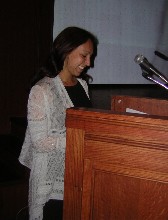 Contemporary New York sizzle got doubled Wednesday at The Pennsylvania Academy of the Fine Arts with Whitney Associate Curator Shamim Momin’s wonderful talk and slide show (image, Momin before her talk began).
Contemporary New York sizzle got doubled Wednesday at The Pennsylvania Academy of the Fine Arts with Whitney Associate Curator Shamim Momin’s wonderful talk and slide show (image, Momin before her talk began). 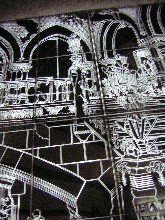 Momin came to speak about New York artist Ellen Harvey, whose elaborate installation, “Mirror,” now dominates the central hall at the original PAFA exhibition space and inserts Modernism into the elegant old building. A petite woman dressed in a black dress and wrapped in a white shawl, Momin unkotted her hair to have her picture taken. Somehow, she remained erect through her talk, balanced on killer shoes (right, a detail view of one side of Harvey’s “Mirror”).
Momin came to speak about New York artist Ellen Harvey, whose elaborate installation, “Mirror,” now dominates the central hall at the original PAFA exhibition space and inserts Modernism into the elegant old building. A petite woman dressed in a black dress and wrapped in a white shawl, Momin unkotted her hair to have her picture taken. Somehow, she remained erect through her talk, balanced on killer shoes (right, a detail view of one side of Harvey’s “Mirror”). Momin is a powerhouse at the Whitney, not only curating the Altria off-site space, but also serving as co-curator of the last Whitney Biennial. She organizes about 5 or 6 shows per year for new artists and curated the POP show at the Whitney, said Alex Baker, who curated “Mirror” for PAFA, introducing Momin.
Momin, helped put “Mirror” in the context of Harvey’s past work for the crowd of about 40 (average age 60, with maybe 6 people under the age of 45).
She began her talk by quoting Harvey: “‘I really like to give people what they want. …But it’s like that saying, be careful what you wish for.'”
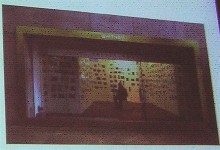 After being invited to create an exhibit as part of the annual series, Contemporary Artists on Contemporary Art, Harvey went through the current collection catalog, which includes 394 works as compared to the entire Whitney permanent collection of 14,000 works. This set her thinking about the process of selection–that the catalog is the institution’s portrait of itself, reflective of a particular moment in time. (At this point in the talk, I myself started thinking about Aaron Levy’s “Beehive” installation about archiving, which is much the same sort of process. See post here.)
After being invited to create an exhibit as part of the annual series, Contemporary Artists on Contemporary Art, Harvey went through the current collection catalog, which includes 394 works as compared to the entire Whitney permanent collection of 14,000 works. This set her thinking about the process of selection–that the catalog is the institution’s portrait of itself, reflective of a particular moment in time. (At this point in the talk, I myself started thinking about Aaron Levy’s “Beehive” installation about archiving, which is much the same sort of process. See post here.)(image from slide show: gold-framed entry into Harvey’s Whitney-Altria installation).
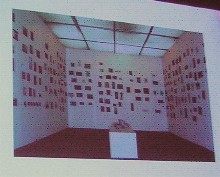 Harvey, she said, was also thinking about the desires of the viewer to see the whole museum when they wander into the offsite Altria space. So she decided to give the viewers what they were expecting–the 394 scaled-down replica paintings of the ones in the Whitney catalog (right, from slide show: a couple of the walls of the installation).
Harvey, she said, was also thinking about the desires of the viewer to see the whole museum when they wander into the offsite Altria space. So she decided to give the viewers what they were expecting–the 394 scaled-down replica paintings of the ones in the Whitney catalog (right, from slide show: a couple of the walls of the installation). To enter the space, the viewers had to step over the bottom edge of a gold frame that Harvey installed around the entrance to the Altria space.
The installation also included seven small cut-outs in the wall, peepholes through which to view seven new acquisitions that postdated the catalog publication.
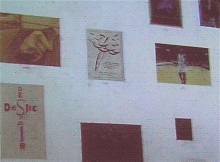 The 394 images were painted directly onto the wall panels, raising the question of whether they are the real object and how much that matters. “Ellen’s work represents the idea of representation,” Momin said. There’s the original object, the photo of it in the catalog, and then Harvey’s painting as a copy of the photo, and at the same time as a real painting (left, from slide show, a detail of some of Harvey’s paintings in the Whitney installation).
The 394 images were painted directly onto the wall panels, raising the question of whether they are the real object and how much that matters. “Ellen’s work represents the idea of representation,” Momin said. There’s the original object, the photo of it in the catalog, and then Harvey’s painting as a copy of the photo, and at the same time as a real painting (left, from slide show, a detail of some of Harvey’s paintings in the Whitney installation).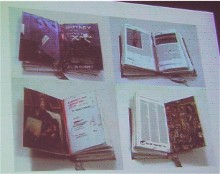 Harvey’s also made her own version of the collection catalog to which she added all the new acquisitions (the seven behind the peepholes plus four that were excluded for conservation and other reasons). Harvey’s hand-made catalog was still another translation of originals and copies, yet a new original. Momin quoted Harvey saying that the catalog was “one of the most insanely derivational works of all time'” (image right, slide of Harvey’s version of the catalog).
Harvey’s also made her own version of the collection catalog to which she added all the new acquisitions (the seven behind the peepholes plus four that were excluded for conservation and other reasons). Harvey’s hand-made catalog was still another translation of originals and copies, yet a new original. Momin quoted Harvey saying that the catalog was “one of the most insanely derivational works of all time'” (image right, slide of Harvey’s version of the catalog).I will continue working on this on Sunday.








